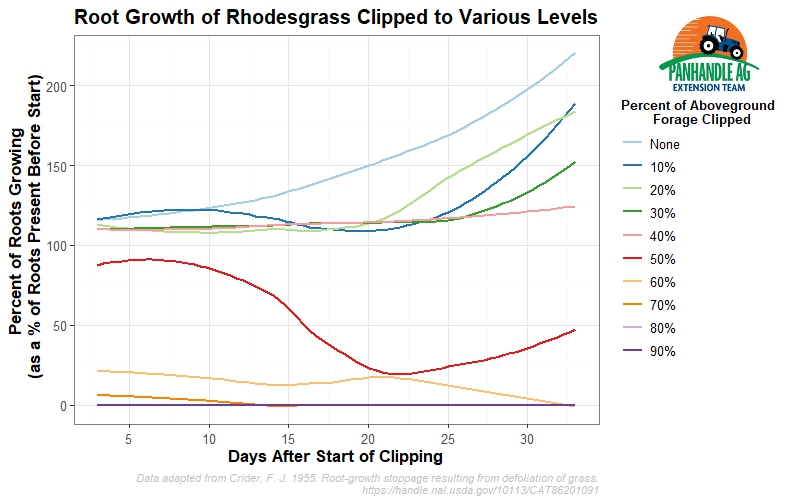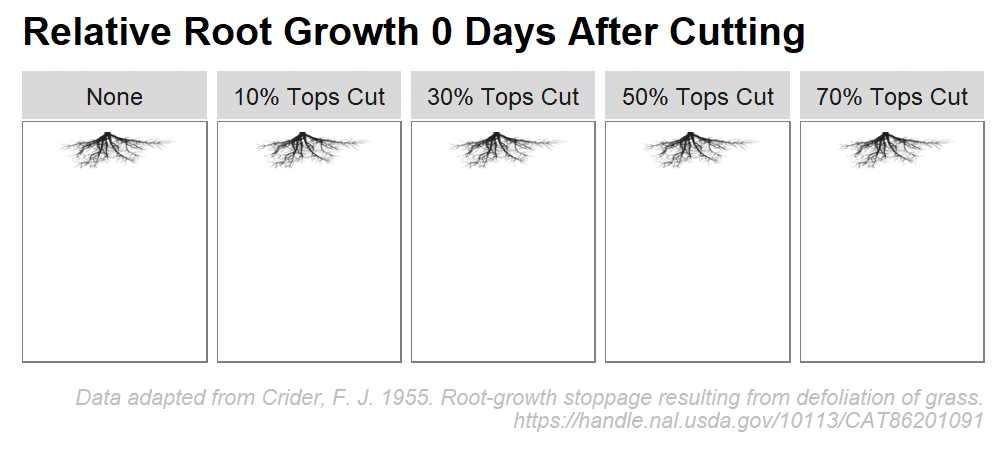Perennial warm-season pasture grasses make up the base for cattle production throughout the Southeast. Through their productivity, these forages support a wide swathe of agricultural industry. We can observe their production in the number of rolls of hay coming off a field, body condition maintained by brood cows, pounds of weaned calves, etc. However, behind the scenes there is a belowground world ruled by roots holding up all that grass. Gaining a better understanding of the roles roots play in supporting forage productivity and their relationship with grazing management and nutrient uptake help us gain a better appreciation for the plant resources that support forage and livestock agriculture as well as inform us for continually improving management.
–
The Role of Roots
Roots provide several main critical functions for a plant: anchoring them in the soil to protect against being washed or blown away by the elements, exploring the soil to uptake nutrients and water, interacting with soil microorganisms to facilitate nutrient availability, and in some cases storing nutrient reserves. Some of our most important forages – bahiagrass, bermudagrass, and perennial peanut all have special belowground plant structures called rhizomes that act as a nutrient foodbank of sorts. These nutrient reserves help them be resilient and maintain productivity under grazing and/or hay cutting.

Side by side comparison of 1-month’s worth of root growth for TifQuick Bahiagrass transplanted as plugs and regularly trimmed to simulate grazing. On the left the grass was trimmed down to 2″ every 2 weeks, on the right the grass was trimmed to 4″ every 4 weeks. Better understanding the effects grazing and cutting has on pasture crops belowground growth can inform our management to avoid overgrazing and promote healthy, prolific pastures. Credit: Kacey Aukema, UF/IFAS
–
How does grazing/cutting affect a forage plant as well as its roots?
Leaves are the main site of photosynthesis, where energy is generated for the plant, nature’s original solar panels. When leaves are removed by grazing or hay cutting, that reduces the available area for photosynthesis to take place. In order for the plant to recover that lost leaf area for photosynthesis, the plant must grow more leaves. With less leaf available to provide energy through photosynthesis, where is the plant going to get the energy it needs to grow more leaves? Using nutrient reserves in roots, bases of stems, rhizomes, and sometimes other plant parts, our pasture grasses can provide the energy necessary to regrow leaves, thus providing more forage for livestock or hay to be cut. As they mobilize these nutrients to power growth of new leaves, the plants often prioritize top growth over belowground growth, and roots often slow down or stop growing completely until the plant has recovered.
Many years of plant breeding have gone into evaluating and improving the varieties of forages we use to best take advantage of these plant characteristics that allow them to continue to be productive and resilient under grazing or cutting pressure. Despite their toughness however, a forage’s ability to regrow after being cut or grazed does have limitations and costs. Just like a vehicle (regardless of fuel efficiency or tank size) will eventually run out of gas if you never stop to fuel up, forages will struggle to thrive and will eventually decline under continuous overgrazing or excessive cutting.
How exactly a plant responds after grazing or cutting depends on a variety of factors: availability of water and nutrients, fertilization, species and variety of the forage, weather, soil, etc. However, one of the most important factors is how severely and how frequently a given forage is cut/grazed back. With light grazing/cutting pressure pasture grasses belowground growth is often relatively unchanged or in some cases even increases some! Generally speaking as grazing/cutting intensity and frequency increases there is a proportionate slowdown in root growth, complete stop of growth, and/or root dieback.
Foundational research in understanding roots responses to grazing/cutting provides us with some examples to get a better handle on the subject. In a series of experiments in the 50s by USDA-Soil Conservation Service Scientist Dr. Franklin J. Crider evaluated root growth of various pasture grasses to better understand these dynamics.

Root growth of Rhodesgrass, a tropical pasture grass, over the course of a month while it was clipped 3x per week to various heights. Root growth completely stopped when greater than 70% of the tops were cut repeatedly. When tops were cut back 40% or less the amount of roots growing did not slow down compared to the amount growing before cutting started. Credit: Kacey Aukema, UF/IFAS. Data adapted from Crider, F. J. 1955. Root-growth stoppage resulting from defoliation of grass.
–
In one experiment rhodesgrass, a warm-season pasture grass, was clipped down 3x a week for a month to various levels to simulate grazing. When more than 70% of the tops were cut the roots stopped growing altogether. When 50% of the tops were removed the root growth slowed down from levels before the start of cutting but did not stop. When less than 40% of the tops were trimmed, root growth did not slow down compared to before cutting. This experiment was also repeated with the same grass with the same varying cutting levels, with only one cutting at the start of the month-long evaluation. In that case, the roots of the grass cutdown to the highest levels did stop growing for a time, but then began to recover. All these results of course were obtained in a controlled environment with this specific species, so this shouldn’t necessarily be directly applied to expected effects of grazing in a real-world field setting, but still give us ballpark understanding of the principle. Continuous grazing/cutting of pasture forages too short, without rest will stop roots from growing and likely eventually lead to decline of that pasture.

Animation of relative root growth of Rhodesgrass, a tropical pasture grass, trimmed down to various levels 3x per week for a month to simulate grazing. Credit: Kacey Aukema, UF/IFAS. Data adapted from Crider, F. J. 1955. Root-growth stoppage resulting from defoliation of grass.
–
Getting to the Root of the Problem
With a reduced number of roots, root growth slowdown, and/or root dieback the pasture plant is limited in its reach to explore the soil to acquire nutrients and water. Affected roots will have a harder time uptaking nutrients that can leach through the soil profile like nitrate from fertilizers given their reduced reach. Therefore, nutrients applied in fertilizer may be less efficiently taken up by plants. As well, overgrazed pasture with a reduced root system will be more strongly affected by drought, as it has less root resources to explore deeper into the soil profile for water. As an overgrazed forage plant allocates its stored nutrient resources to try to grow new leaves that are again and again removed before they can adequately replenish energy reserves, the plant will eventually run out of gas for both above and belowground growth.
Understanding the belowground effects of overgrazing on a pasture plant are a reminder of the importance of proper grazing and/or cutting management to foster health and continued productivity of valuable forage resources. Despite best efforts towards proper management, in the real world, sometimes there are just some things you can’t control. Extenuating circumstances may lead to an overgrazed pasture situation. Knowledge of grazing management and its implications on belowground plant growth are still useful to inform management decisions to help the pasture recover. Giving adequate rest from grazing after a period of continuous heavy grazing, adequate fertilization to supply readily available nutrients, split applications of fertilizer to avoid nutrient losses resulting from leaching, and paying attention to weed control when the grass is less able to compete with unpalatable species are a few ways you work towards getting an overgrazed pasture back on track.
–
Further information about grazing management:
Grazing Management – Making the Most of Available Forage
Grazing Management Concepts and Practices
–
References:
Root-growth Stoppage Resulting from Defoliation of Grass – F.J. Crider. 1955
Effects of grazing on the roots and rhizosphere of grasses.– Grassland ecophysiology and grazing ecology . 1 . 2000
- Silvopasture 101 Workshop and Farm Tour Recap - May 3, 2024
- What does the Future Hold for your Farm or Ranch? - November 3, 2023
- The Lowdown on Belowground – Pasture Grass Roots - May 19, 2023
